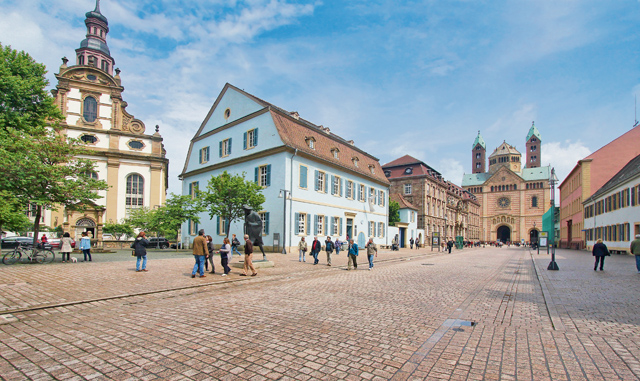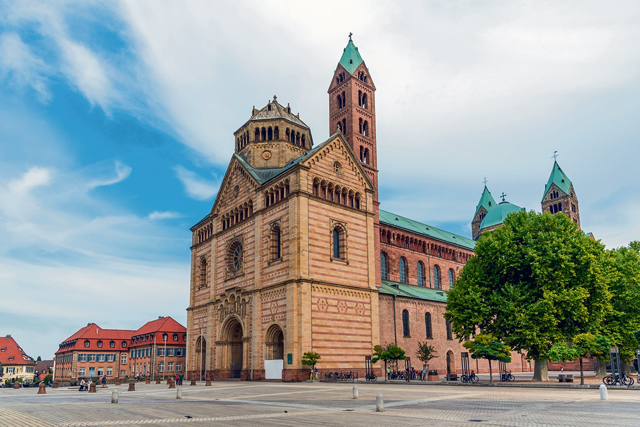
Speyer is a town in the Rhineland-Palatinate and is close to the Rhine River. One of the oldest cities in Germany, the town was recorded on one of the Greek geographer Ptolemy’s maps, dated 150 AD, as Noviomagus. There are many delightful parts of Speyer to explore, and its location in Germany’s wine-growing region makes it especially inviting.
What to see in Speyer
The Kaiserdom (Imperial Cathedral)
You can’t miss the imposing Romanesque Kaiserdom (Imperial Cathedral), as the town is dominated by its four spires and two domes. Its actual full name is the Imperial Cathedral Basilica of the Assumption and St Stephen (Dom zu Unserer lieben Frau in Speyer).
It was founded by Konrad II in 1030 and was rebuilt by Henry IV. The church is now a UNESCO World Heritage Site and attracts many tourists. The crypt is the final resting place of some of Germany’s rulers and bishops. Today it is the largest Romanesque church in the world.

Don’t miss the huge stone font, with a capacity of 1,560 litres, that lies in the square in front of the cathedral’s main portal. This once symbolized the borderline between the diocese and the city of Speyer.
The Old City Gate
The Old City Gate was part of the city wall and the western gate. The fortifications had 68 wall and gate towers. The top floor was added in the 16th century, while the steep roof and the lantern date back to the beginning of the 18th century.
Visitors can climb the tower for a superb view of the city. On your way up it, stop at the second floor to see the permanent exhibition which traces the history of the fortifications and that of the gate.
The City Hall
The City Hall is a late-Baroque building with an imposing exterior. The council chamber is in the early Rococo style and is now used for functions such as concerts and weddings.
The Old Fish Market
The fish and wood market was located in the old town, which is now marked by a sculpture of a fish.
Speyer’s Museums
The Technik Museum Speyer has planes, vintage cars, motorbikes and fire engines, and is perfect for those interested in the history of transport. There’s a submarine as well as a Lufthansa jumbo jet, a Russian Buran orbiter and many other fascinating exhibits.
The Historical Museum of the Palatinate is close to the cathedral and is dedicated to the history of Speyer and the surrounding region. It houses five permanent collections that encompass Prehistory, Roman Times, the Cathedral Treasury, the Modern Era and the Wine Museum. The Munich architect, Gabriel von Seidl, designed the castle-like museum, which opened in 1910 and was renovated in the late 1980s. Inside this museum is the Young Person’s Museum of Speyer, which was the first museum especially for young people in the Rhineland-Palatinate region.
The Carnival Museum is dedicated to the history of the Carnival in Speyer and has exhibits on four floors of the tower and in an annex. The history of the carnival goes back to 1296, so there are some fascinating exhibits.
Sea Life Speyer
If you are into sea creatures, then this is the place to go. You enter an undersea world where colorful fish, sharks and Marty, the green sea turtle, live. There are fresh and salt-water tanks, and the museum takes up two floors, so you have many creatures to view and marvel at.
What to do in Speyer
Hiking: There are urban hikes in Speyer as well as more traditional hikes in the countryside or forest. Visitors can also follow in the (presumed) footsteps of Saint James on his journey to the Path of St. James to Santiago de Compostela.
Cycling: The World Heritage Cycling Route runs through Speyer gives visitors the opportunity to explore three of Germany’s states. You can also cycle along the banks of the Rhine, or there’s the Palatia Route which takes you through wine country. Naturally enough, there is the oenophile (wine-lovers) route which goes from Speyer to Edesheim.
Wine tasting: There are several wine bars in Speyer including Weinstube Klosterstübchen, Weinstube Rabennest and Weinstube Schwarzamsel. Of course, if you venture outside the city you will find vineyards where you can sample the wine and traditional food.


